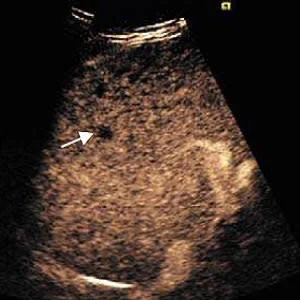Point-of-care ultrasonography has distinct advantages over computed tomography (CT) in terms of portability, cost, lack of ionising radiation, and improved spatial resolution. Still, CT has superior diagnostic accuracy in many urgent and emergent conditions. Contrast-enhanced ultrasound (CEUS) using intravascular microbubbles holds promise to close this diagnostic gap for several clinical applications relevant to emergency care, according to an article in press in the American Journal of Emergency Medicine.
"CEUS is a promising imaging technique for point-of-care applications in paediatric and adult patients and can be applied for patients with allergy to CT contrast medium or with impaired renal function," the article points out. "More high-quality CEUS research focusing on accuracy, patient safety, healthcare costs, and throughput times is needed to validate its use in emergency and critical care settings."
CEUS using intravascular microbubbles has potential to revolutionise point-of-care ultrasonography by expanding the use of ultrasonography into clinical scenarios previously reserved for CT, magnetic resonance imaging, or angiography. Tobias Kummer, MD, Department of Emergency Medicine, Mayo Clinic, Rochester, MN, and colleagues performed a literature search and reported clinical experience to describe current applications of CEUS for point-of-care indications.
Notably, the uses of CEUS include several applications highly relevant for emergency medicine, such as solid-organ injuries, actively bleeding haematomas, or abdominal aortic aneurysms. The researchers explain: "Compared with CT as the preeminent advanced imaging modality in the emergency department, CEUS is low cost, radiation sparing, repeatable, and readily available. It does not require sedation, preprocedural laboratory assessment, or transportation to the radiology suite."
Today's commercially available ultrasonography contrast agents (UCAs) are stable and easy to use compared with earlier agents. Moreover, these agents are not cleared renally, thus no nephrotoxic effects occur. This characteristic enables their use without first obtaining laboratory assessment.
CT's static nature means that image quality is frequently degraded by motion-blurring artefacts that can interfere with interpretation. In comparison, the researchers say, CEUS is a dynamic imaging technique for imaging with patient motion, both voluntary and involuntary. Also, CEUS can acquire images over a time period, allowing prolonged or repeated imaging to account for variable contrast enhancement of tissues that can mimic pathologic characteristics, especially on CT.
On the other hand, there are also disadvantages in using CEUS, including:
- Optimal visualisation of second-generation UCAs uses the nonlinear harmonic properties of the microbubbles, which body tissue can also produce.
- Use of UCAs adds several steps to an ultrasonography evaluation, including placement of peripheral intravenous access.
- CEUS is operator-dependent and requires supplemental training and expertise.
In addition, an upgrade of existing ultrasonography equipment may be needed because the use of UCA requires specific software, and cost may be associated with increased requirements for hospital imaging storage space.
Nonetheless, application of CEUS is evolving continuously, and wider adoption of this technique is expected, especially with the predicted refinement and enhancement of this imaging modality, according to the article. For example, CEUS can provide new insights into renal perfusion and pathogenesis of acute kidney injury for patients in the ED or ICU and potentially help physicians identify patients at risk for renal failure and aid early intervention to prevent acute kidney injury.
"As CEUS moves forward in the ED setting, more high-quality research in this setting is needed to validate its utility," Dr. Kummer and co-authors write. "Research is needed that specifically addresses physician training, as well as CEUS accuracy in the hands of emergency medicine physicians and the feasibility of CEUS programme implementation in the ED."
Source: American Journal of Emergency Medicine
Image Credit: R. Badea and Simona Ioanitescu
References:
Kummer T et al. (2018) Emergency and critical care applications for contrast-enhanced ultrasound. Am J Emerg Med Published online: April 21, 2018. https://doi.org/10.1016/j.ajem.2018.04.044
Latest Articles
computed tomography, CEUS, Contrast-enhanced ultrasound, Point-of-care ultrasonography
Point-of-care ultrasonography has distinct advantages over computed tomography (CT) in terms of portability, cost, lack of ionising radiation, and improved spatial resolution. Still, CT has superior diagnostic accuracy in many urgent and emergent conditio






